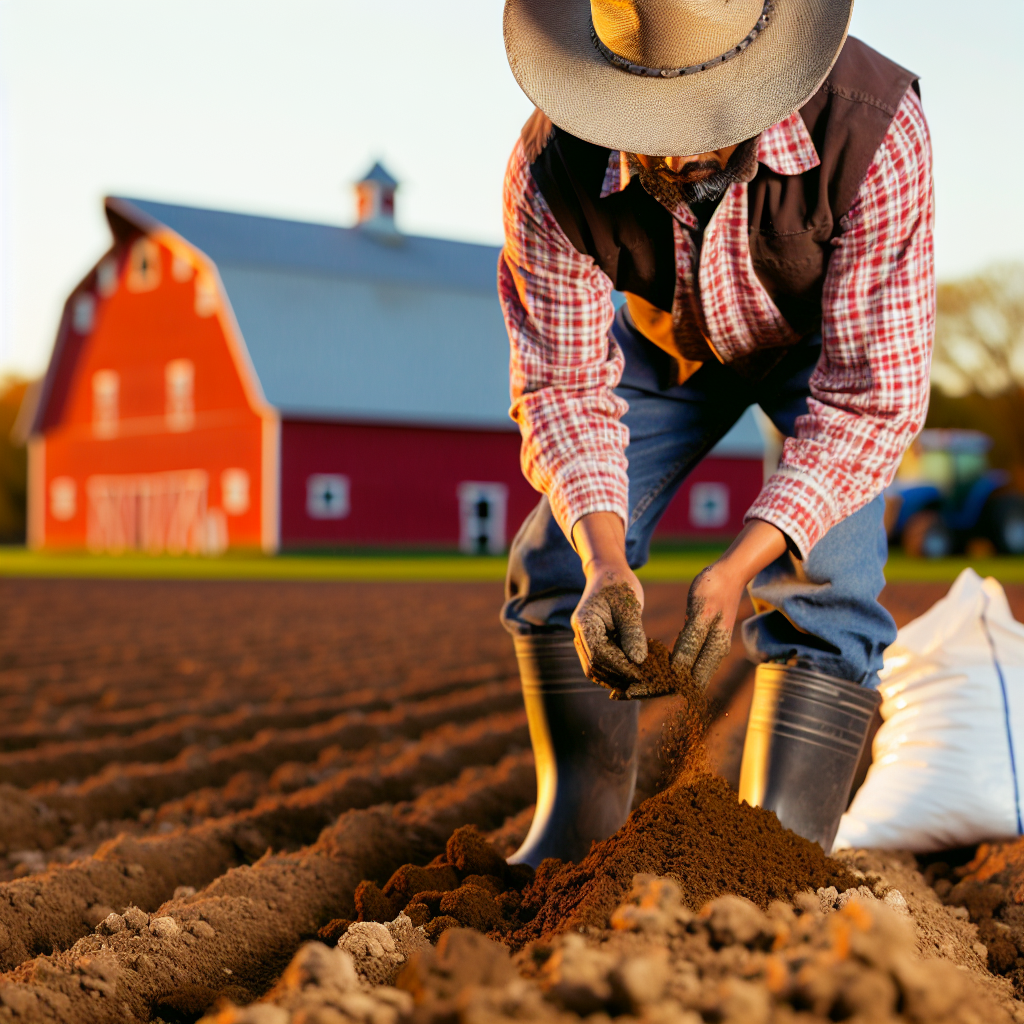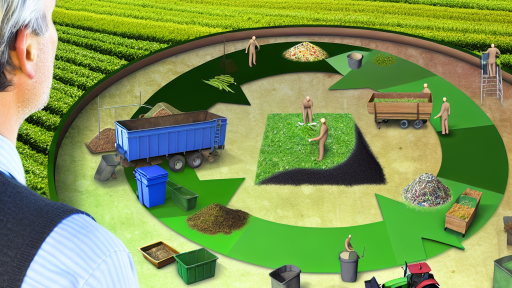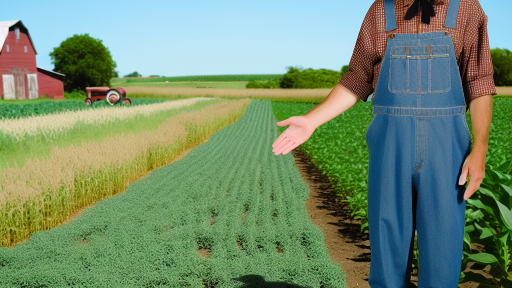Introduction to Soil Health and Its Importance in Sustainable Farming
Soil health plays a critical role in the sustainability of farming practices.
Healthy soil influences crop productivity and ecosystem function.
Furthermore, it supports biodiversity and nutrient cycling.
It ensures that crops receive adequate nutrients for growth.
Additionally, soil health helps retain moisture, reducing irrigation needs.
Defining Soil Health
Soil health refers to the ability of soil to function effectively.
It encompasses biological, physical, and chemical properties.
Healthy soil promotes plant growth while maintaining environmental quality.
Indicators of soil health include organic matter, pH, and microbial activity.
Impact of Soil Health on Crop Production
Soil health directly affects crop yields and quality.
Healthy soils promote robust root development in plants.
This, in turn, leads to improved nutrient uptake and stability.
Moreover, healthy soils can help mitigate pests and diseases.
The Role of Soil Health in Ecosystem Services
Soil health contributes to essential ecosystem services.
These include water filtration, carbon storage, and habitat provision.
Transform Your Agribusiness
Unlock your farm's potential with expert advice tailored to your needs. Get actionable steps that drive real results.
Get StartedHealthy soils enhance biodiversity and support wildlife populations.
They play a key role in combating climate change by sequestering carbon.
Challenges to Soil Health
Several factors pose challenges to maintaining soil health.
These include soil erosion, contamination, and compaction.
Additionally, the overuse of chemicals can degrade soil quality.
Urbanization and land-use changes also threaten soil integrity.
Practices to Enhance Soil Health
Implementing sustainable practices can improve soil health significantly.
Cover cropping helps protect against erosion and enhances soil structure.
Crop rotation promotes nutrient diversity and ecological balance.
Reduced tillage minimizes disturbance and preserves soil organisms.
Furthermore, adding organic matter boosts microbial activity and fertility.
Key Indicators of Soil Health
Soil Structure
Soil structure significantly influences water flow and root penetration.
Well-structured soil has pores of various sizes.
This variety enhances aeration and supports microbial life.
Nutrient Availability
Nutrient levels determine soil fertility and crop yield.
Key nutrients include nitrogen, phosphorus, and potassium.
Regular soil testing helps monitor nutrient concentrations.
Biological Activity
Soil health relies on a diverse community of organisms.
Microbes, earthworms, and insects play crucial roles.
These organisms improve soil structure and nutrient cycling.
pH Levels
Soil pH affects nutrient availability for plants.
A neutral pH range is ideal for most crops.
Low or high pH can lead to nutrient deficiencies.
Organic Matter Content
Organic matter enriches soil with nutrients and improves structure.
Showcase Your Farming Business
Publish your professional farming services profile on our blog for a one-time fee of $200 and reach a dedicated audience of farmers and agribusiness owners.
Publish Your ProfileIt enhances water retention and supports microbial networks.
Regular addition of compost can boost organic matter levels.
Water Holding Capacity
Water retention is critical for plant health.
Healthy soils can hold more moisture during dry spells.
Improving organic matter is one effective strategy.
Soil Compaction
Soil compaction restricts root growth and water infiltration.
It often results from heavy machinery use.
Aeration techniques can alleviate compaction issues.
Carbon Sequestration
Healthy soils capture and store carbon from the atmosphere.
This process helps mitigate climate change effects.
Practices like cover cropping enhance carbon storage capabilities.
Monitoring Soil Health
Regular assessments help track soil health indicators.
Farmers can adjust practices based on assessment results.
Long-term monitoring supports sustainable farming practices.
Cover Cropping: Benefits and Best Practices
Understanding Cover Cropping
Cover cropping involves planting specific crops to enhance soil health.
Farmers use cover crops during off-seasons between main crops.
This practice provides numerous agronomic benefits.
Additionally, it improves soil structure and prevents erosion.
Benefits of Cover Cropping
Cover crops offer several significant benefits for farmers.
- They improve soil fertility through nitrogen fixation.
- Cover crops reduce nutrient runoff, protecting waterways.
- They help suppress weeds, minimizing the need for herbicides.
- Cover crops enhance soil moisture retention.
- They provide habitat for beneficial insects and wildlife.
Best Practices for Implementing Cover Crops
Farmers should consider the following best practices.
- Select appropriate cover crop species for local conditions.
- Time planting carefully to maximize benefits.
- Ensure proper termination of cover crops before planting main crops.
- Monitor soil health regularly to assess improvements.
- Incorporate diverse species to enhance ecological benefits.
Choosing the Right Cover Crops
Selecting the right cover crop is crucial for success.
Some common options include clover, vetch, and rye.
Each species has unique benefits and characteristics.
Farmers should match cover crops to their specific farming goals.
Challenges of Cover Cropping
While beneficial, cover cropping also poses challenges.
Farmers may face difficulties in managing cover crops in adverse weather.
They might also worry about the additional costs involved.
Communication with local agricultural extensions can help address these issues.
Successful Case Studies
Many farmers report success with cover cropping.
For example, Emily Johnson in Iowa improved soil health through cover crops.
Similarly, Robert Martinez in Texas successfully reduced erosion.
These case studies illustrate the benefits of this practice.
You Might Also Like: Soil Regeneration Techniques For Modern Farms
Crop Rotation Strategies for Enhancing Soil Fertility
Introduction to Crop Rotation
Crop rotation involves alternating the types of crops grown on a specific piece of land.
This practice helps maintain soil health and reduces pest populations.
Moreover, rotating crops improves nutrient cycling in the soil.
Benefits of Crop Rotation
Crop rotation offers numerous benefits for sustainable farming.
- Enhances soil fertility by adding variety to nutrient requirements.
- Helps prevent soil erosion by maintaining ground cover.
- Reduces the need for chemical fertilizers and pesticides.
- Promotes biodiversity in the soil ecosystem.
Effective Crop Choices
Choosing the right crops is crucial for successful rotation.
Legumes, such as clover and peas, enrich the soil with nitrogen.
Cereal crops, including corn and wheat, reduce soil erosion.
Showcase Your Farming Business
Publish your professional farming services profile on our blog for a one-time fee of $200 and reach a dedicated audience of farmers and agribusiness owners.
Publish Your ProfileRoot crops, like potatoes and carrots, enhance soil structure.
Creating a Crop Rotation Plan
Creating an effective crop rotation plan requires careful consideration.
Begin by assessing the soil’s nutrient needs and the previous crops grown.
Next, determine which crops will improve soil health based on those needs.
Additionally, consider the growth cycles and harvest times of the crops.
Implementation and Monitoring
Implementing a crop rotation plan requires ongoing monitoring and adjustments.
Regularly assess soil health and crop performance during each season.
Adjust the rotation schedule based on the observed outcomes.
Finally, document changes and improvements in soil fertility over time.
Gain More Insights: Organic Farming Infrastructure Tips For Sustainable Growth
Soil Health Practices for Sustainable Farming
Organic Amendments: Composting and Mulching Techniques
Organic amendments play a vital role in enhancing soil health.
Composting is one of the most effective methods available.
In this section, we focus on different composting techniques.
Understanding these techniques can improve your farming practices significantly.
Benefits of Composting
Composting enriches soil and improves its structure.
It enhances the soil’s water retention capabilities.
Moreover, compost adds essential nutrients to the soil.
The process supports beneficial microbial life, which boosts plant health.
Ultimately, composting helps reduce waste by recycling organic materials.
Types of Composting Techniques
Diverse composting techniques suit various needs and settings.
Each method has unique benefits and considerations.
Hot Composting
Hot composting generates heat through microbial activity.
This method speeds up decomposition significantly.
It typically requires frequent turning to maintain temperature.
Hot composting produces mature compost within a few weeks.
Cold Composting
Cold composting allows organic materials to decompose without heat.
This process is slower but requires less maintenance.
It’s ideal for those with limited time or resources.
Over time, materials break down naturally, enriching the soil.
Bokashi Composting
Bokashi composting uses anaerobic fermentation to break down waste.
This method is excellent for kitchen scraps and dairy products.
It produces a nutrient-rich liquid that can be diluted and used as fertilizer.
Additionally, it minimizes odors and speeds up decomposition.
Mulching Techniques for Soil Health
Mulching protects soil and enhances its health.
It reduces erosion and suppresses weed growth effectively.
Organic mulches contribute to nutrient cycling as they decompose.
This process enriches the soil over time, promoting plant vigor.
Types of Mulches
Several types of mulches can be used in sustainable farming.
Each type provides different benefits based on materials and use.
Straight and Hay Mulch
Straight and hay are excellent for suppressing weeds.
Showcase Your Farming Business
Publish your professional farming services profile on our blog for a one-time fee of $200 and reach a dedicated audience of farmers and agribusiness owners.
Publish Your ProfileThey help maintain soil moisture and temperature.
These materials break down slowly, providing nutrients over time.
Wood Chips and Bark
Wood chips and bark are popular for landscape beds.
They create a visually appealing appearance while protecting soil.
This type of mulch can prevent soil compaction as well.
Grass Clippings
Grass clippings are an accessible and effective mulch option.
They add nitrogen back into the soil as they decompose.
However, they should be applied in thin layers to avoid matting.
Implementing Organic Amendments
To achieve optimal results, integrate composting and mulching practices.
Start with small areas to test and monitor effectiveness.
Maintain regular schedules for compost turning and mulching application.
Document changes in soil condition and plant health over time.
Adjust practices based on specific needs and observations.
Find Out More: Enhancing Soil Health through Integrated Pest Management
Reduced Tillage and Its Impact on Soil Structure
Defining Reduced Tillage
Reduced tillage refers to minimal disturbance of the soil.
This method maintains soil structure and health.
Farmers employ reduced tillage to enhance soil biodiversity.
Additionally, it helps retain moisture within the soil.
Benefits of Reduced Tillage
One major benefit is improved soil structure.
This practice promotes the formation of soil aggregates.
Consequently, increased aggregation leads to better aeration.
Furthermore, it enhances water infiltration and drainage.
Soil Health and Microbial Activity
Reduced tillage positively affects microbial activity in the soil.
This practice provides a stable habitat for beneficial organisms.
Soil microbes play a crucial role in nutrient cycling.
In turn, vibrant soil biology contributes to plant health.
Impact on Erosion Control
Implementing reduced tillage significantly reduces soil erosion.
Less soil disturbance minimizes the risk of runoff.
This approach helps maintain topsoil, which is vital for productivity.
Moreover, it helps preserve organic matter levels in the soil.
Integrating Cover Crops
Farmers can enhance reduced tillage with cover crops.
Cover crops reduce soil compaction and improve structure.
Additionally, they contribute organic matter through biomass.
This combination increases overall soil fertility and productivity.
Technology and Future of Reduced Tillage
Advancements in agricultural technology support reduced tillage.
Modern equipment allows for precise soil management.
This technology maximizes the benefits of reduced tillage practices.
Farmers can expect improved overall sustainability in their operations.
You Might Also Like: IPM Best Practices for Sustainable Agriculture

Integrated Pest Management (IPM): Protecting Soil Microbial Communities
Introduction to IPM
Integrated Pest Management is a holistic approach to pest control.
Showcase Your Farming Business
Publish your professional farming services profile on our blog for a one-time fee of $200 and reach a dedicated audience of farmers and agribusiness owners.
Publish Your ProfileIt focuses on maintaining healthy ecosystems.
Moreover, it minimizes the use of chemical pesticides.
Importance of Soil Microbial Communities
Soi microbial communities play a vital role in ecosystem health.
They enhance soil fertility and nutrient cycling.
Additionally, they help suppress soil-borne diseases.
Principles of IPM
IPM integrates various pest management strategies.
These strategies include biological, cultural, and mechanical methods.
Furthermore, it emphasizes monitoring pest populations regularly.
Biological Control
This method uses natural predators to manage pest populations.
For instance, ladybugs can control aphid numbers effectively.
Cultural Practices
Cultural practices modify farming techniques to deter pests.
Crop rotation is a prime example of this approach.
This practice disrupts pest life cycles and improves soil health.
Mechanical Control
Mechanical control involves physical methods to remove pests.
Traps and barriers are common examples of this strategy.
Benefits of IPM on Soil Health
IPM practices promote the preservation of soil microbial communities.
Healthy microbes contribute to improved soil structure.
As a result, they enhance water retention and root growth.
Implementing IPM on Your Farm
Start by monitoring pest levels and identifying species present.
Next, assess the potential impact of various control measures.
Finally, choose strategies that align with your sustainable goals.
Future Directions for Sustainable Farming
IPM supports sustainable farming by protecting soil health.
Embracing integrated approaches leads to resilient agricultural ecosystems.
Ultimately, it fosters a balanced relationship between farming and nature.
Water Conservation Practices to Support Soil Health
Importance of Water Conservation
Water conservation is critical for maintaining healthy soil.
It prevents soil erosion and maintains its structure.
Moreover, conserving water enhances nutrient retention in the soil.
This practice leads to healthier crops and better yields.
Techniques for Effective Water Conservation
Implementing specific water conservation techniques can greatly benefit soil health.
Drip Irrigation
Drip irrigation delivers water directly to the plant roots.
This method minimizes evaporation and runoff.
As a result, it conserves water while keeping soil moisture levels steady.
Rainwater Harvesting
Collecting rainwater can significantly reduce the demand on groundwater.
Farmers can use rain barrels or cisterns for storage.
This harvested water can irrigate crops during dry spells.
Cover Cropping
Growing cover crops protects soil from erosion during off-seasons.
They improve soil organic matter and enhance water infiltration.
This practice allows for better moisture retention in the soil.
Managing Soil Moisture
Maintaining proper soil moisture is essential for plant health.
Mulching
Applying organic mulch around plants helps retain soil moisture.
Showcase Your Farming Business
Publish your professional farming services profile on our blog for a one-time fee of $200 and reach a dedicated audience of farmers and agribusiness owners.
Publish Your ProfileThis layer also suppresses weeds and regulates soil temperature.
Consequently, it creates a conducive environment for soil organisms.
Soil Testing
Regular soil testing helps farmers understand their soil’s moisture needs.
It reveals nutrient deficiencies that affect water retention.
Adjusting practices based on test results enhances soil health.
Benefits of Water Conservation Practices
Implementing these practices provides multiple benefits.
They promote sustainable agricultural practices that enhance productivity.
Additionally, they contribute to long-term soil health and resilience.
Ultimately, effective water conservation fosters a sustainable farming future.
Community and Stakeholder Engagement in Promoting Soil Health Practices
Importance of Engagement
Community and stakeholder engagement enhances the promotion of soil health practices.
Engaged communities are more likely to adopt sustainable methods.
Furthermore, collaboration fosters a culture of shared learning and innovation.
Building Partnerships
Creating partnerships between farmers and research institutions is vital.
These collaborations provide essential resources and knowledge.
Moreover, they can lead to tailored solutions for local soil health issues.
Educational Initiatives
Education plays a crucial role in promoting soil health practices.
Workshops and seminars can empower farmers with knowledge.
Additionally, educational materials can raise awareness among the community.
Examples include brochures, videos, and online courses.
Utilizing Local Expertise
Local experts can guide communities in best practices.
Farmers field days provide hands-on experience and demonstrations.
Engaging local agriculture extension agents can also enhance outreach.
Incentives for Participation
Incentives encourage participation in soil health initiatives.
These may include grants, subsidies, or technical assistance.
Financial support can reduce barriers to adopting new practices.
Feedback Mechanisms
Establishing feedback mechanisms is crucial for continuous improvement.
Community forums allow stakeholders to express their views.
Regular surveys can assess the effectiveness of implemented practices.
Success Stories
Sharing success stories motivates others to engage.
Highlighting local farmers who successfully adopt soil health practices inspires others.
These narratives can be shared through social media and community events.
Long-term Commitment
Long-term commitment is necessary for sustainable change.
Ongoing support and resources strengthen community efforts.
Ultimately, sustained engagement leads to improved soil health outcomes.
Additional Resources
Beyer, Lawler, and Pingree Introduce Bipartisan Legislation to …




